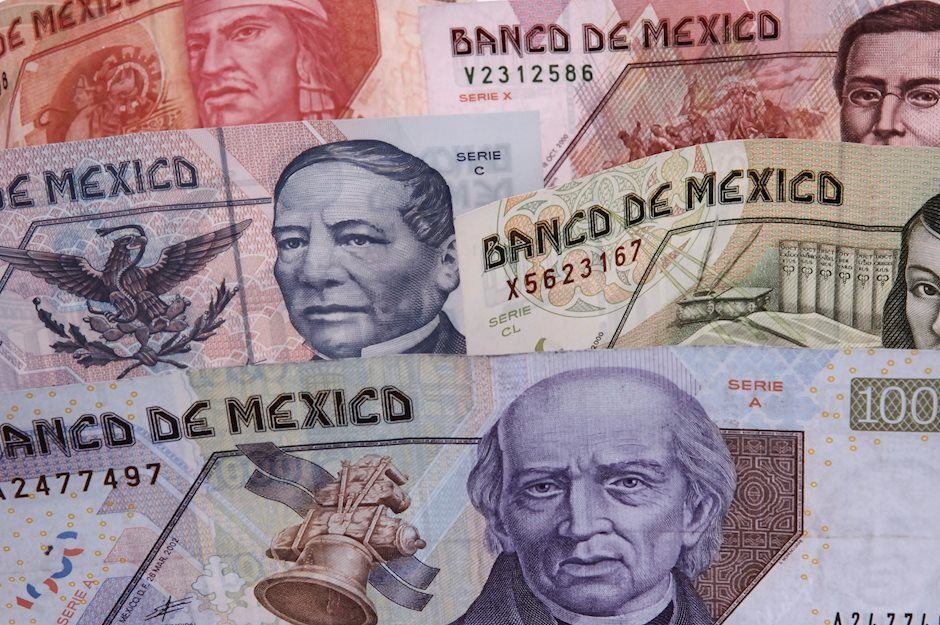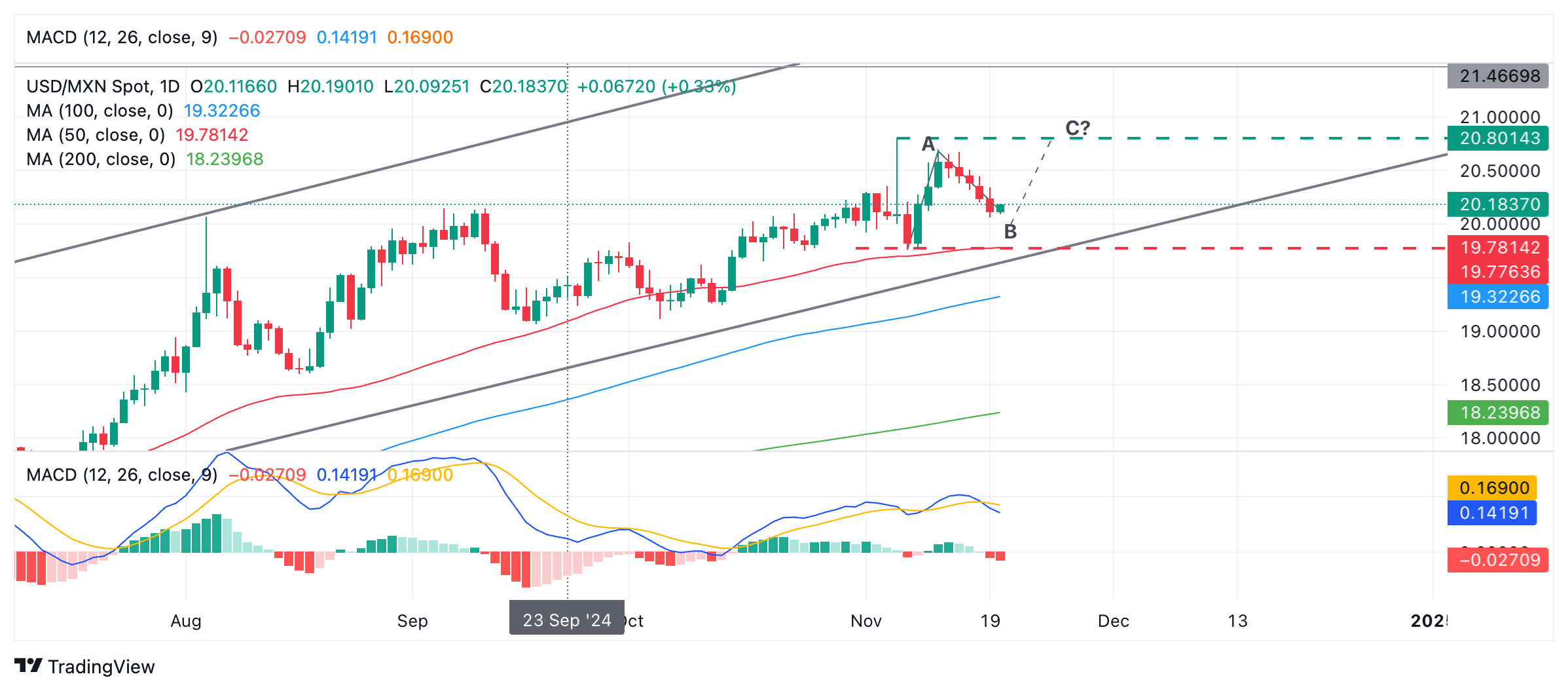Created
: 2024.11.20














![]() 2024.11.20 19:42
2024.11.20 19:42
The Mexican Peso (MXN) whipsaws between tepid gains and losses in its key pairs - USD/MXN, EUR/MXN and GBP/MXN - during the European session on Wednesday. A sudden ramping up of geopolitical uncertainty is causing ripples in global financial markets, and idiosyncratic factors are also an ingredient to the mix. Markets are jittery after Russia's announcement that it has lowered the bar for the deployment of nuclear weapons in response to the US agreeing to allow Ukraine to use US-made missiles to strike targets in Russia.
This follows a five-day winning streak for the Mexican Peso built on the back of the waning effect of the Trump-trade on the US Dollar (USD), optimistic growth and deficit-reduction plans of the Mexican government, and a positive lift from the outcome of the Bank of Mexico's (Banxico) November policy meeting.
The Mexican Peso trades mixed on Wednesday amid heightened market volatility following Russian President Vladimir Putin's announcement that Russia had amended its so-called Nuclear Doctrine - its conditions for using nuclear weapons - to include conventional attacks from non-nuclear nations if they are backed by a nuclear state. The revision was interpreted as a direct warning to the US after it allowed Ukraine to strike targets in Russia using US-made long-range ATACMS (Army Tactical Missile System) missiles. According to Russian state media, Ukraine fired six such missiles at a Russian military facility in the Kursk Oblast on Tuesday.
According to the Associated Press, "Putin.. (..) emphasized that Russia could use nuclear weapons in response to a conventional attack posing a "critical threat to our sovereignty," a vague formulation that leaves broad room for interpretation."
The Mexican Peso has been in a steady uptrend over the last five days as the USD-bullish effect of the Trump-trade fades. The Peso could still face further headwinds, however, as the scope and size of the US's intended trade tariffs clarify.
US President-elect Donald Trump still has to name the US Trade Representative. However, rumors continue circulating that he may give the role to Robert Lighthizer, who has been described as an "arch hawk on trade" by ING bank. Such a move would probably end the Mexican Peso's brief recovery.
Trump's choice of Marco Rubio as Secretary of State suggests further risks for the Mexican economy and the Peso, as Rubio is known for his tough stance on left-wing Latin American governments. Apart from taking a harder line on obvious targets such as Venezuela, Cuba and Nicaragua, Rubio could also attack Mexican ties with Beijing.
"He is also likely to push governments in the region to clamp down on Chinese investment and influence in their countries," writes Kimberley Sperrfechter, Emerging Markets Economist at Capital Economics. "Mexico is likely to bow to that pressure, whereas others' willingness to comply with US demands will be influenced by the depth of their geopolitical ties with Beijing and their trade balances vis-à-vis China," she adds.
The Peso has also seen gains after the Bank of Mexico revised up its forecast for inflation in 2024 to 4.7% from 4.3%. The change suggests the central bank will probably not cut interest rates as aggressively as previously expected - a positive for the Peso since maintaining elevated interest rates increases capital inflows into a country, supporting its currency.
The Mexican Peso successfully shrugged off Moody's Ratings cut Mexico's credit rating from Baa2 "Stable" to "Negative" last Thursday. The rating agency based its decision on expectations that the country will run a high budget deficit of 5.9% of Gross National Product (GDP) in 2024 (its highest since the 1980s). It also highlighted risks to the economy from the government's judiciary reforms, which Moody's views as threatening the rule of law and "eroding checks and balances" to the executive's power.
However, Mexican Finance Minister Rogelio Ramírez de la O quickly pushed back at the downgrade, saying that Moody's had not taken into account his budget for 2025, which was published the following day, Friday.
In the 2025 budget, Ramírez de la O forecast an increase in GDP of between 2% and 3% and a much lower budget deficit of 3.9% of Gross Domestic Product (GDP) (from a projected 5.9% in 2024). Large cost savings to the Departments of Security and Health, backed by robust growth, will lower the deficit. The Peso seems to have been buoyed by his optimism.
Analysts' responses have been mixed, with Gabriela Siller, an analyst at Banco BASE, arguing that "The rosy estimates make it unlikely that the deficit and debt forecasts are reached," according to Reuters.
However, others were more positive: "In general terms the budget proposal meets expectations: it shows a considerable reduction in the deficit without fueling concern of a potential economic recession," said analysts at CIBanco in a note. "The economic outlook is optimistic," which "should be enough to remove one more fear from investors," they added.
USD/MXN continues pulling back within a rising channel. The short-term trend is unclear and possibly sideways - but the longer-term trend remains bullish.
The pullback (wave "B" on the chart below) from the November 12 high (top of wave "A") is still declining and could fall down to support at 19.78 (red dashed line) at the November 7 swing low, 50-period Simple Moving Average (SMA) and base of the channel.

After that, however, USD/MXN will probably extend a new leg higher in line with its broader up cycles, and this could see prices return to the zone between 20.80 (November 6 high) in a wave "C?" (green dashed line) of a three-wave Measured Move pattern which might be currently evolving (waves A, B and C?).
Further, a break above 20.80 would confirm a higher high and an extension of the medium and long-term bullish trend and unlock the next upside target at 21.00 (round number), where buyers could start to meet resistance.
The Mexican Peso (MXN) is the most traded currency among its Latin American peers. Its value is broadly determined by the performance of the Mexican economy, the country's central bank's policy, the amount of foreign investment in the country and even the levels of remittances sent by Mexicans who live abroad, particularly in the United States. Geopolitical trends can also move MXN: for example, the process of nearshoring - or the decision by some firms to relocate manufacturing capacity and supply chains closer to their home countries - is also seen as a catalyst for the Mexican currency as the country is considered a key manufacturing hub in the American continent. Another catalyst for MXN is Oil prices as Mexico is a key exporter of the commodity.
The main objective of Mexico's central bank, also known as Banxico, is to maintain inflation at low and stable levels (at or close to its target of 3%, the midpoint in a tolerance band of between 2% and 4%). To this end, the bank sets an appropriate level of interest rates. When inflation is too high, Banxico will attempt to tame it by raising interest rates, making it more expensive for households and businesses to borrow money, thus cooling demand and the overall economy. Higher interest rates are generally positive for the Mexican Peso (MXN) as they lead to higher yields, making the country a more attractive place for investors. On the contrary, lower interest rates tend to weaken MXN.
Macroeconomic data releases are key to assess the state of the economy and can have an impact on the Mexican Peso (MXN) valuation. A strong Mexican economy, based on high economic growth, low unemployment and high confidence is good for MXN. Not only does it attract more foreign investment but it may encourage the Bank of Mexico (Banxico) to increase interest rates, particularly if this strength comes together with elevated inflation. However, if economic data is weak, MXN is likely to depreciate.
As an emerging-market currency, the Mexican Peso (MXN) tends to strive during risk-on periods, or when investors perceive that broader market risks are low and thus are eager to engage with investments that carry a higher risk. Conversely, MXN tends to weaken at times of market turbulence or economic uncertainty as investors tend to sell higher-risk assets and flee to the more-stable safe havens.
![]()
Created
: 2024.11.20
![]()
Last updated
: 2024.11.20

FXStreet is a forex information website, delivering market analysis and news articles 24/7.
It features a number of articles contributed by well-known analysts, in addition to the ones by its editorial team.
Founded in 2000 by Francesc Riverola, a Spanish economist, it has grown to become a world-renowned information website.
We hope you find this article useful. Any comments or suggestions will be greatly appreciated.
We are also looking for writers with extensive experience in forex and crypto to join us.
please contact us at [email protected].
Disclaimer:
All information and content provided on this website is provided for informational purposes only and is not intended to solicit any investment. Although all efforts are made in order to ensure that the information is correct, no guarantee is provided for the accuracy of any content on this website. Any decision made shall be the responsibility of the investor and Myforex does not take any responsibility whatsoever regarding the use of any information provided herein.
The content provided on this website belongs to Myforex and, where stated, the relevant licensors. All rights are reserved by Myforex and the relevant licensors, and no content of this website, whether in full or in part, shall be copied or displayed elsewhere without the explicit written permission of the relevant copyright holder. If you wish to use any part of the content provided on this website, please ensure that you contact Myforex.
Myforex uses cookies to improve the convenience and functionality of this website. This website may include cookies not only by us but also by third parties (advertisers, log analysts, etc.) for the purpose of tracking the activities of users. Cookie policy